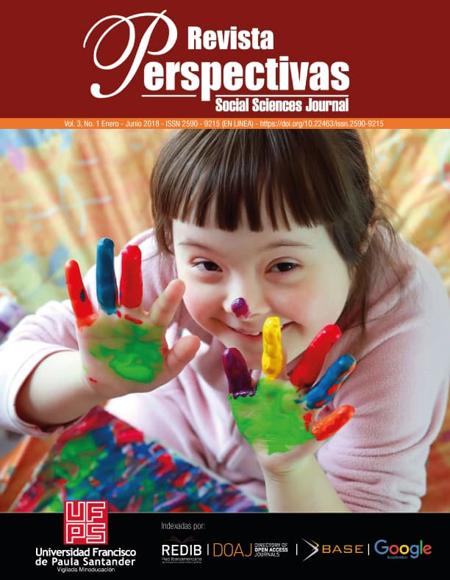Uso de espacios virtuales de aprendizaje en el fortalecimiento de competencias para la formulación del proyecto de vida en contextos de conflicto escolar
Uso de espacios virtuales de aprendizaje en el fortalecimiento de competencias para la formulación del proyecto de vida en contextos de conflicto escolar
Contenido principal del artículo
La incorporación de un laboratorio virtual entre los estudiantes de educación básica secundaria permite trabajar dentro del contexto colombiano el fortalecimiento del proyecto de vida de manera innovadora, atractiva e interactiva entre estudiantes, docentes y padres de familia. Se trata de una vía que favorece la disminución de los altos niveles de conflicto escolar que representa una alternativa mediadora y preventiva frente a las amenazas y los riesgos a los que están expuestos los alumnos en edad preadolescente. Este estudio es de naturaleza descriptiva cuantitativa. Para la recogida de los datos se aplicó un instrumento de escala tipo Likert mediante el cual se evalúan los aspectos relacionados con el contexto educativo, el contexto socio afectivo del estudiante y el nivel de desarrollo de competencias TIC. Los ítems versaron sobre la formación y ejecución del proyecto de vida por parte de los estudiantes. Los resultados permiten detectar las fortalezas, debilidades, amenazas y oportunidades que se sintetizan en una matriz DOFA. Los hallazgos permiten incluir nuevos actores y acciones con el fin de seguir apoyando y orientando a los estudiantes a fin de impactar positivamente sus proyectos, clarificando y fortaleciendo sus metas en función de los recursos educativos y socioafectivos de los cuales dispone.
Descargas
Datos de publicación
Perfil evaluadores/as N/D
Declaraciones de autoría
- Sociedad académica
- Universidad Francisco de Paula Santander
- Editorial
- Universidad Francisco de Paula Santander
Detalles del artículo
Camargo, A. M. (1996). Sobre la violencia escolar. Ponencia presentada en el Quinto Congreso Nacional de Prevención y Atención del Maltrato Infantil. Santafé de Bogotá: Universidad Pedagógica Nacional.
Chamilo.org. (s.f.). Chamilo LMS o Chamilo Learning Management System. Obtenido de http://www.chamilo.org/es/acerca-de-chamilo
Delgado Salazar, R., y Lara Salcedo, L. (2008). De la mediación del conflicto escolar a la construcción de comunidades justas. UniversitasPsychologica, 7 (3), 673-690.
Erazo Santander, O. A. (2010). Reflexiones sobre la violencia escolar. Revista de Psicología GEPU, 1 (3), 74 - 86.
Fearon, J. D. (2000). La deliberación como discusión. En J. Elser (Comp.), La democracia deliberativa(pp. 65-94). Barcelona: Gedisa.
Me siento.com. (06 de 05 de 2011). 7 soluciones para resolver conflictos en la escuela. Recuperado el 30 de 11 de 2015, de http://www.mesiento.com/7-soluciones-para-resolver-conflictos-en-la-escuela
Open Exp. (2014). CHAMILO LMS: el e-learning ético. Chamilo LMS (pág. 20). Mataika: Reuter. Obtenido de http://www.openexpo.es/blog/elearning/chamilo-lms-el-e-learning-etico
Oraisón,M.M. (2000). La escuela: ambiente moral y participación democrática. IRICE,14, 115-128.
Prieto, J. P. (2013). Virtu@lmente. Obtenido de Una aproximación metodológica al uso de redes sociales en ambientes virtuales de aprendizaje para el fortalecimiento de las competencias transversales de la Universidad EAN: http://journal.ean.edu.co/index.php/vir/article/view/1397
Rico González, C. A. (2011). Diseño y aplicación de ambiente virtual de aprendizaje. Palmira: Universidad Nacional de Colombia.
UNICEF. (08 de 2013). Programa TIC y la educación basica. Recuperado el 30 de 11 de 2015, de Estado del arte sobre el desarrollo cognitivo involucrado en los procesos de aprendizaje y enseñanza con integración de las TIC: http://www.unicef.org/argentina/spanish/Estado_arte_desarrollo_cognitivo.pdf
Zapata Ros, M. (Ed.). (2011). Evaluación de la calidad en entornos sociales de aprendizaje. Revista de Educación a Distancia(29). Obtenido de http://revistas.um.es/red/article/view/232571/0









